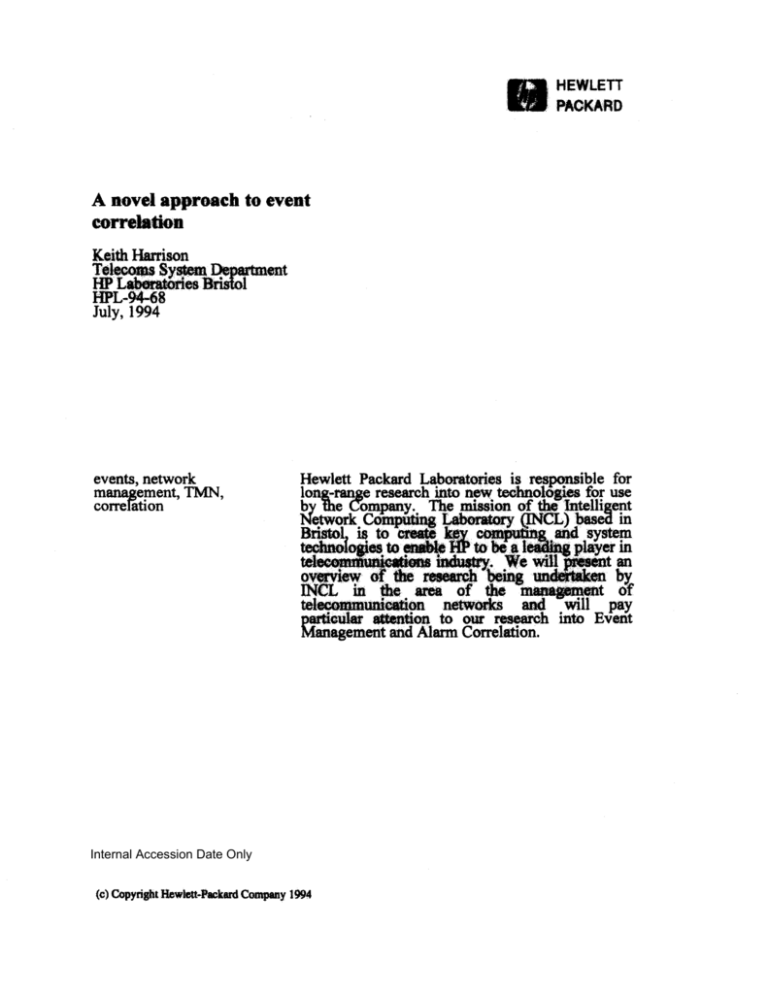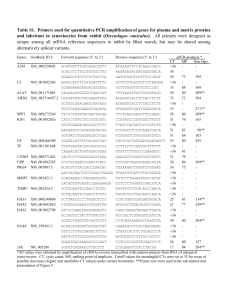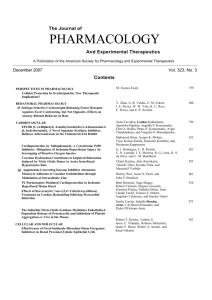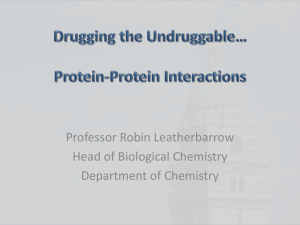A novel approach to event correlation
advertisement

•. . , ',HEWLen
.'" •. ··PACKARD
A Dovel approach t9 eveRt
correlatio.
Keith Harrison
T'leCO$$
DeP8J,1:ment
FW L .' Sy"
···esBri.stGl
HPL~
68
July, 1994
events, network
management, TMN,
correlation
Hewlett Packard Laboratories is res~ible for
long..r an., research i,nto new tecbnolo$iPs for use
9Y the Co~.
..' y Th
..· .0 miss.J.Oft.'. of . ~.lu~te...ll1
l.tig'jent
~twork. Co~ ~ . "CL) lJase(l in
BrmoL 1$ to.
'.
- •.• .
and system
teduto1ops,to..., ..... ' to \WJ~ I .,player in
.1 ' . ' ittd.u~. Jtepsent an
q
,...' lie ~. 'belfti-cleilken by.
Itt til. . . of . . ~ . t of
teI~~~neMOtb and .will ,pay
p$'tl
.•.' • ctllflt . .tiOll to 0lU' research mtoEvent
Management and Alarm Correlation.
Internal Accession Date Only
(0) CopyrigbtHewlett.Packard Company 1994
1. Introduction
The purposeof this paper is to give an overview into some of the research being carried out by
HPLabsin the area of event correlation as part of a largerinvestigation into the open management
of large-scale heterogeneous telecommunication networks.
We define Event Correlation to be processing that involves multiple events - as opposed to
Event Filtering that treats each event independently.
This work on event couelatian was motivatedby two rea!-wGl'1d concerns: the baDdling of large
volumes of events from a single fault, andthe determination of the fault that underlies the
observed events.
2.1 Volume of Traffic
The first coaGCm is tbat of volume.Whoaafou1t 0CCUl'$ on a network,theaetworkemits a shortlived storm of evetlts. Pol'example. a breakin a SONET cable .yresult ina stQnn of many
thousands of events. Similatly, when the cable is restored. a restoration storm of similar size may
occur.
ev t creation rate
""--------------------+time
Each event is typically shipped across a data network to one or more network management applications. Somewbere along the way it will be loged for audit purposes. As higher bandwidth
transmission standards are adopted, such as OC192, this event storm will reach epic proportions it is not infeaaible for an OCl92 break to result in excess of one million events. Ideally, we should
think about reducing this traffic by perfoI1lling some form of data comprrtssion., and by performing this as early as possible. Obviously, this data compression should be done in such a way that
no useful information is lost. An architecture for achieving this might look like:
The eventsemitted by the networkare sent to local data compressors where their bulk is reduced.
This reduced Bow of events is then sent to regional data compressors and so on, up to the central
network management application.
It would defeat the purposeof the architecture if all events had to be sent to the application for
logging. There is an assumption that logging will be performedlocally,and if a consolidated log
is required, then this can be performedoff-lineduringthe quiet periods.
2.2 The Cause Not the Symptoms ...
The operator is not interestedin the aetual events. They are more interestedin knowingwhat the
underlyingfault is that triggered the events. Thistask has been traditionally attacked usingexpert
systems technology and involves a S<Jphisticated form of pattern matching. It is assumedthat a
fault produces a standard patternof events - detect the pattern and you can determine the fault.
Both problems, described in 2.1 and 2.2, may be solvedby using a pattern matchingtechnology.
In the firstcase we haveheavy traffic but the patternsbeing detected are typicallyvery simple. In
the second case, we can take advantage of the reduced event traffic, but the patternsbeing
detected are more sophisticated.
This gives us a design objective:
2
Objective:
Develop a single technology that can tackle both the
data compression of large volumes of events AND
the determination of the underlying pathology.
In practice, expert systems can be developed that are considerably more powerful than patternmatchers. The assumption is that the 80-20 rule applies. That is, a large percentage of the problems that arise in a network have been planned for and their event patterns predetermined. It may
well be necessary to use Expert System technologies to handle the remaining problems however
this can take advantage of the much reduced, and enriched, stream of events emitted by the data
compressors.
3. The Use of Expert Systems Technologies
Event correlation has, to date, been tackled in a variety of ways:
**
*
Using specially written application code
Using table driven pattern matching code
Using Expert Systems Shells, such as ART or G2
Writing specialised code is expensive and time consuming although the results can run impressively quickly. The disadvantage being that the code is inflexible and difficultto enhance and
maintain.
Using expert system shells permits the designer to concentrate on the problem of specifying the
required correlation rules without having to worry about other housekeeping tasks at the possible
cost of efficiency- and, in some cases, unpredictability of response times.
Event Correlatorstypically lose interest in events once the events become old. For example, it is
unlikely that any correlator would be interested in an event that is more than 24 hours old.
Because we cannot, and do not want to, store events within the correlator indefinitely, we are
requiredto find a strategy for releasing out-of-date events. "Events don't die they just fade away."
3
This gives us a second designobjective:
Objective:
Develop a technology that can offerefficientand
continuous operation over longtimescales.
4. What is an Event?
In order to obUlin a solution that is as..j oneral as possible. and thus more amenableto reuse. it is
necessarytodeteI'Illinethe essentialcbar8cteristics of events.The chosen set is as follows:
* An event has a type
* Each event is ti:mestamped upon creation
* Events have to be sont from the issuing device to the correlator. This transit delay will
takea raRdem but bolurIed·leDath of time.
*Events mayarrive out of otdet.
Note that in 0.- to correlate we. aoing to have to be able to say wb.etber one event was ereated before or after at1Qdlerand wluniadle timediffereace. This mquires the events to be timestamped at the time of creation - U$iaa a global tiJne rtfemnce. In practice it is sufficient to know
which device issued tbe event and bow far adrift its <:iockis. A second problemoccurs because
the clock resolutionis not always tinecnougb. For example. TLI typically has a one second clock
resolution. In this case. unambiguous ordering is goingto necessitate the event emittor to tag the
event with an incrementing counter.
5. The Basic Idea
The event handlingarchitecture described in section 2.1 assumes the existence of a data compressor that is capableof accepting multiple streams of events, correlating the events, and then creating one or more streamsof eventsfor use elsewhere.
4
{Ed
Correlator
The resulting streamofevents may be a subsetof the origiDal stream,or comprise events of a new
type. This COImlator sboWd be driven, or OOJltl'Olled..bya U$« sWIied specification. It should
also be capaWe ofbeiag dlicient and scalable.·1KJthin tums· of the arrival rate of events and the
complexity of the cc:m:elations to be performed.
reatize·"
The key insight was to
this ID8CJ'()oolevel an:hiteeture remains validwhenused at the
micro-level. Thus. the iatemaIs oftbe em:mlator.t have the foIk>wingstrueture:
The q~ontben becemes - can wedesian a small number of siIDple. etlicient andeasily understood nodes that maybe combinedtogether to provide pnx:e8Sors with desited behaviour?
1.
It is easy to see that this architecture is suitable for parallel processing.
tlWfOlilDd within .~
desian. Digital circuits are
constructed by ~NANl).·NOa and MOT.... intbe ~ manuer. In order to
ease this task. standard. COlIlbiDations of d1eseprimitives have been packaged as multiplexors,
This CODcept is not diS$imilar to
half-adders, tlip-flopsor even microprocessors.
It is important to recognise that our "hardware" components are implemented in software - and
thus may be easily customised.
6. An Example
5
A detailed description of all of the standard components isbeyond the scope of this paper. To give
a flavour we will consider a very simple problem:
Imagine we have a hardware device that emits two types of events LOW -- the power level is getting dangerously low
OK -- the power level is acceptable again.
We might require only those LOW events which are not associated with a powerloss transient.
That is. the LOW power event is not immediately followed by a power OK event.
Similarly we want to see those powerOK events that mark the end of such a long power shortage.
Thus
input events
LOW
*
i'
l'S
S
output events
That is. we wish to specify the circuitry needed to complete the following:
LOW events
OK events
?•
Unmatched OK
events
6
One solution, making use of two types of nodes is as follows:
unless,
LOW
LOWs marking
start of long power
low.
(0. 1)
unless2
OK
(-1,0)
OKs marking end
of long power low.
Any event entering a Bus node is forwarded to each of the successor nodes.
The Unless node has the property that events presented to the excitor input will be outputted
unless a matching event arrives at the inhibitor event. We can visualise the Unless node as:
Excitor events
Unless node
Output Events
I Excitorllnbibitor predicate
_ _ _ _ .II Inhibitor Wmdow
The match criterion contains two pieces of information:
1. What is the required time relation between the inhibitor and the excitor event? In the upper
Unless node, unless}. the LOW event is the excitor event and the OK event is the inhibitor event.
The upper Unless node requires the OK event to have been created after the LOW event - but by
no more than one second. Similarly, in the lower Unless node. unlessj, the OK event is the excitor
event and the LOW event is the inhibitor event. The LOW event must have been created before
the OK event, but by no more than one second.
2. What relation, involving event attributes, must be satisfied between the two events? In this case
we require the LOW and OK events to have originated from the same device.
7
7. Processing Delays
This simple example illustrates an unavoidable fact of life. LOW events will need to be delayed
until the system is quite sure whether or not a matching OK event is going to arrive. Even assuming there are no transit delays, this might result in a one second delay before the LOW is sent to its
successor.
This gives us a third design objective:
Objective
Unnecessarydelays should not be engineered into
the system
Note: In the example, if we have no transit delays to worry about then the OK events will not be
delayed because the inhibiting LOW event must have already arrived.
8. Memory Management
Once implemented, the event correlator is going to have to run for a long time, in some cases for
several years. Consequentlyit is important that events be released as soon as possible. By examining the Unless node in detail, we will see that its memoryrequirements are well defined and lead
to a simple and efficient memory management scheme.
The Unless node has two input streams of events - the excitor stream and the inhibitor stream. An
event from the excitor stream will be outputted if, and only if, there is no matching event in the
inhibitor stream such that the inhibitor event was created within a specified time window relative
to the excitor event, and the two events satisfy some predefined criteria such as they come from
the same device. These semantics are implementedas follows:
On receipt of an excitor event we must:
* check to see if an acceptable inhibitor event has already been received. This is done by
searching through a memory containingrecently received inhibitor events. If so, then
processing is terminated.
Note: Even if we require the inhibitor event to havebeen created AFfER the excitor event
it is still possible that, because of transit delays, the inhibitor event arrived BEFORE
the excitor.
8
* check to see whether there is still time for an inhibitor event to arrive. If not, then the
excitor event can be immediately output. If there is still time, then the excitor event is
placed into an "excitor memory".
On receipt of an inhibitor event we must:
** check
Place
inhibitor event into an "inhibitor memory".
the store of excitor events. Any stored excitor events that matches may
the
be
removed- they have been inhibited.
Note: An inhibitor event may inhibit many excitor events.
Finally,periodically we must search the excitor memory. Any excitor event thatis sufficientlyold
that no matching inhibitor event could possibly arrive may be output and removed from the excitor memory. Similarly,inhibitor events in the inhibitor memory will eventually become sufficiently old that no matching excitor events could arrive, in which case they may be removed.
In order to consider how long events need to stored, consider the following diagram:
creation timeof excitor event
arrival window of excitor
inhibitor creation window
arrival window of inhibitors
c
t
inhibitor storage duration
1<
--~
excitor storage duration -----=;:~
""E:--- transit dclayof outputted excitors
The line at time c represents the creation time of an excitor event. Because of minimum and maximum transit delays for an excitor event, we do not know the precise time this event will arrive,
but we do have an arrival window - the interval (d, f).
Associated with the Unless node is a time interval. Any inhibitor event that is a match for the
excitor event must have been created within this window - the interval (a, e).
Because of the known bounds on the transit delays for the inhibitor events, we have an arrival
window for the range of acceptable inhibitor events - the interval (b, g).
9
From this diagram it is possibleto deduce the following:
The earliest that the excitor event can arrive is d. But the latest that the matchinginhibitor
can arrive is g. Thus we may have to store the excitor events for (g - d).
The earliest that the inhibitor event can arrive is b. But the latest that an interestedexcitor
can arrive is f. Thus we may have to store the inhibitorevents for (f - b).
We cannot release an excitor event until we know the inhibitor event cannot arrive. Thus,
we have to wait until time g before the excitor may be emitted. This means the excitor
event emitted from the unless node will have a transit delay of (g - c).
An implicationof the analysisgiven above is that althoughthe Unless node has to have memory
to store events we can predict, a priori, the maximum length of time we have to store the events.
Any events that have passed their "sell-by date" may be released. Similar analysis is possibleand
required for all node types.
9. Summary
In this paper we have describeda technology that satisfies the three design objectives. Namely:
1. develop a single technology that can tackle both the data compression of large volumes
of events and the determination of the underlying pathology;
2. develop a technology that can offer efficientand continuous operation over long timescales;
3. unnecessarydelays should not be engineered into the system.
The system is based on the novel notion of streams of events that are processed using simple
processingelements that are composedto produce sophisticated correlations.
The system has been implemented and is running in the laboratory where the initial results have
been found to be extremely promising. Workis in progressto test the system in a real environment to characterise its performance and to determinethe level of support needed to aid the circuit
designer.
Because an abstractdefinition of an event was adopted, this technologyhas found other uses apart
from event correlation.For example, it can be used for consolidatingbilling records into a single
billing record for the call.
10









